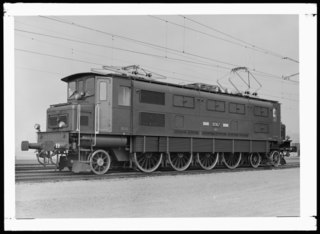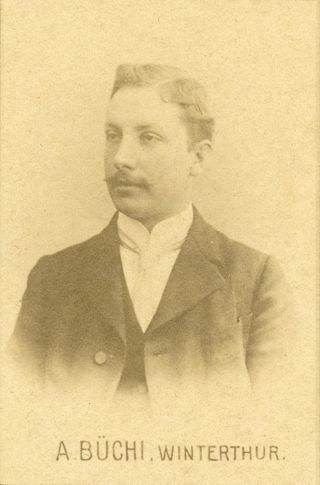

Walter Boveri (born 21 February 1865 in Bamberg, Kingdom of Bavaria, died 28 October 1924 in Baden, Switzerland) was a Swiss-German industrialist and co-founder of the global electrical engineering group Brown, Boveri & Cie. (BBC).


Walter Boveri (born 21 February 1865 in Bamberg, Kingdom of Bavaria, died 28 October 1924 in Baden, Switzerland) was a Swiss-German industrialist and co-founder of the global electrical engineering group Brown, Boveri & Cie. (BBC).
Boveri's ancestors originally came from Savoy and settled at the beginning of the 17th century in Iphofen, Lower Franconia. By 1835 they were in Bamberg. Walter was born in 1865 as the third of four sons of the doctor Theodor Boveri. The second oldest son Theodor Boveri junior became a well-known biologist. His brother Theodor married to biologist Marcella O'Grady and they were the parents of journalist Margret Boveri. As a 17-year-old Walter Boveri joined the Royal Engineering School in Nuremberg. He finished this in 1885 and then moved to Switzerland. There he was first volunteer and later assembly manager for electrical systems at Maschinenfabrik Oerlikon (MFO).
In 1887, Charles Eugene Lancelot Brown, technical director of MFO, envisaged setting up his own business. Boveri teamed up with him and started looking for investors, but remained unsuccessful for several years. In 1891 Boveri married Victoire Baumann. Before the marriage, he received a generous loan from his future father-in-law, the Zurich silk industrialist Conrad Baumann. Brown and Boveri signed an association agreement in December 1890, and three months later they chose Baden as the company location. The founding of Brown, Boveri & Cie. (BBC) took place on 2 October 1891. Two years later, Boveri received Swiss citizenship. In 1895 he had the Villa Boveri built for himself and his family.
Brown took care of the company's technical affairs, while Boveri, though technically gifted, took on the role of visionary commercial director. He was assisted by his cousin Fritz Funk, whom he had taken on as a limited partner in the company. Boveri was responsible for growing BBC into a large international company.
In connection with the construction of the Ruppoldingen hydro-electric plant near Rothrist, Boveri founded the power company Olten-Aarburg AG in 1894, which became Aare Tessin AG in 1936. He decided that another company was needed for the planning, financing and construction of power plants so, in 1895, he founded Motor AG which later became Motor-Columbus. [1]
After Brown retired to private life Boveri was, from 1911 to 1924, Chairman of BBC. He presided over various electricity companies and, during World War I, the Société Suisse de Surveillance Economique. His work on railway electrification earned him a place on the board of Swiss Federal Railways. As president of various municipal commissions, he was also active in Baden's local politics. [2]
Boveri's sons Theodor and Walter junior later worked in various roles within the company. His brother Robert (1873-1934) led the subsidiary, BBC Mannheim, for several years until his death. Robert's son, William Boveri, was employed there until the 1970s as a director.

Allmänna Svenska Elektriska Aktiebolaget was a Swedish industrial company.

Charles Eugene Lancelot Brown was a Swiss businessman and engineer who co-founded Brown, Boveri & Cie (BBC), which later became ABB.

Brown, Boveri & Cie. was a Swiss group of electrical engineering companies. It was founded in Baden bei Zürich, in 1891 by Charles Eugene Lancelot Brown and Walter Boveri who worked at the Maschinenfabrik Oerlikon. In 1970 BBC took over the Maschinenfabrik Oerlikon and in 1988 it merged with ASEA to form ABB.

The Blonay–Chamby Museum Railway is a short 3-kilometre-long (1.9 mi) steep but adhesion worked metre gauge heritage railway operated as part of the Blonay–Chamby Railway Museum using vintage steam and electric locomotives and rolling stock. It uses the Blonay–Chamby railway line, originally built by the Chemins de fer électriques Veveysans. It is rail-connected at both ends, at its upper terminus, at Chamby Station on the Montreux–Lenk im Simmental line and at the lower end at Blonay station on the Vevey–Les Pléiades railway line operated by Transports Montreux–Vevey–Riviera.

The Ae 4/7 was a universal locomotive of the Swiss Federal Railways, employing the so-called Buchli drive.

Maschinenfabrik Oerlikon was a Swiss engineering company based in the Zürich district of Oerlikon known for the early development of electric locomotives. It was founded in 1876 by the industrialist Peter Emil Huber-Werdmüller, and occupied a large site immediately to the west of Oerlikon railway station.
Boveri is the surname of several people:

The Rhaetian Railway Ge 4/6 was an eight member class of metre gauge 1′D1′ electric locomotives formerly operated by the Rhaetian Railway (RhB), which is the main railway network in the Canton of Graubünden, Switzerland.

Baden, sometimes unofficially, to distinguish it from other Badens, called Baden bei Zürich or Baden im Aargau, is a town and a municipality in Switzerland. It is the main town or seat of the district of Baden in the canton of Aargau. Located 25 km (16 mi) northwest of Zürich in the Limmat Valley mainly on the western side of the river Limmat, its mineral hot springs have been famed since at least the Roman era. Its official language is German, but the main spoken language is the local Alemannic Swiss-German dialect. As of 2018 the town had a population of over 19,000.

The Rhaetian Railway ABe 4/4 was a class of 11 kV 16.7 Hz AC metre gauge railcars operating on the so-called core network of the Rhaetian Railway (RhB), which is the main railway network in the Canton of Graubünden, Switzerland.

The Dolderbahn is a 1.3 km (0.81 mi) long rack railway in the Swiss city of Zürich. The line is in Zürich's Hottingen and Fluntern suburbs on the south slope of the Adlisberg mountain. The lower terminus of the line is at Römerhof, some 1.5 km (0.93 mi) from the city centre, where it connects with lines 3 and 8 of the Zürich tramway. The upper terminus at Bergstation Dolderbahn is adjacent to the Dolder Grand Hotel and the Dolder recreation area. Two intermediate stations, at Titlisstrasse and Waldhaus Dolder, are also served.

Gustav Guanella was a Swiss inventor who held numerous patents.

Alfred Büchi was a Swiss engineer and inventor. He was best known as the inventor of turbocharging. Büchi was born July 11, 1879, in Winterthur, Switzerland, growing up there and in Ludwigshafen. He was the son of Johann Büchi, a chief executive at Swiss industrial engineering and manufacturing firm Sulzer.
Peter Emil Huber-Werdmüller was a Swiss industrialist who founded the engineering company Maschinenfabrik Oerlikon. He was the son of Johann Rudolf Huber, a Zurich silk manufacturer and studied mechanical engineering from 1855 at the Swiss Federal Polytechnic Institute in Zurich. In 1858 he received his diploma as an engineer and then supplemented his knowledge at the Conservatoire National des Arts et Métiers in Paris. He was also in England for a long time, where he was able to acquire more knowledge.

A Velox boiler is a turbocharged, forced circulation, water-tube boiler which utilises an axial flow compressor and a gas turbine. Velox boilers, also known as Velox steam generators, were developed in the early 1930s by the Brown Boveri Company (BBC) of Switzerland. Velox boilers were the first commercially available machines to make use of axial compressors and played a pivotal role in the later development of BBC’s industrial gas turbines.

Andre August Jaecklin is a Swiss electrical engineer and was a university teacher. He made contributions in different fields of electronics starting with telecommunications, followed by data storage while in California and notably semiconductor devices for power applications. In particular, he is a pioneer of optically fired thyristors in the field of power electronics.

Peter J. Wild is a Swiss electronics engineer and a pioneer of liquid-crystal display (LCD) technology.

Fritz Leutwiler was a Swiss economist. After his studies at the University of Zurich, he worked at the Schweizerischer Bankverein, the predecessor of today's UBS, in London.

The Neuchâtel gas turbine is the world's first electric power-generating gas turbine to go into commercial operation. It was designed and constructed by Brown, Boveri & Cie and installed in 1939 at the municipal power station in Neuchâtel, Switzerland. The gas turbine was in-service as a standby unit from 1940 till its retirement in 2002.
Sidney William Brown was a Swiss machine designer and art collector.